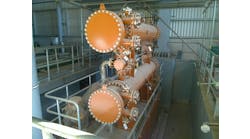THIS MONTH'S PUZZLER
We use a vacuum knockout pot to push vapor produced from a batch polymerization reactor and a neutralization tank to a caustic scrubber. Caustic is recirculated over a chevron demister and through packing. The vacuum is only about 12 psia to avoid losses from the polymer reactor, which contains a solid catalyst. The process periodically suffers from pH upsets in the neutralization tank, corrosion in the vacuum pot, poor temperature control, loss of vacuum from seals, fouling of the vacuum pump rings, and fouling in the demister pad, which only survives a few weeks. We're tearing down this process every week to avoid trouble and the cost is killing us. There's a further complication — we periodically use the batch reactor and tank to make other products. Can you suggest any ways to improve reliability?
COMBAT CONTAMINATION
The process provides plenty of opportunities for contamination that could cause problems. First, the reactor and neutralizer share a common knockout pot. Second, these tanks handle multiple products. Third, water, the cooling medium, may not be compatible with the polymer or any coproducts. You may want to investigate compatibility of the water with the chemicals sampled from the separator sump; chemical treatment could help and be economical for a closed system like the circulated water in the sump. Also, investigate the cleaning between production campaigns and, if needed, make changes in campaigns involving incompatible chemicals.
Four changes may offer immediate improvement: 1) replace the chevron pad with a double mesh pad having a coarse pad leading into a fine pad; 2) consider moving the vacuum pump to after the scrubber to protect the pump against corrosion and fouling; 3) filter the water to remove any accumulated solids and films that could be forming in the separator; and 4) add corrosion inhibitor to the wetting water lubricating the vacuum pump rings — a filter could be useful here, too.
Installing a separate knockout pot for the reactor may provide a long-term solution. This may require some changes to the hydraulics of the process.
You may want to consider a heat exchanger for the caustic makeup for the tower. The packing depth may be inadequate; either cooling the circulating fluid or makeup, or increasing the flow rate through the tower could improve capture of the acid.
Also, as a precaution, consider changing gaskets throughout the system if vacuum failure is an issue.
Dirk Willard, process engineer
Fluor Global Services, Inver Grove Heights, Minn.
MAY'S PUZZLER
We're experiencing quality problems that we've never had before with delayed coker (DC) feed that we supply to another refinery. The feed, which is 100% residue hydroconversion residue, takes about a day to travel via rail tank cars from our site to the other refinery. The problem is that the material pops and bubbles (anywhere in the range of 80° to 200°C) during the ignition temperature tests upon arrival — and so is rejected and sent back. We sample the DC feed before dispatch, taking material from the top of the rail tank cars, and don't observe any popping and bubbling during our ignition temperature test. We haven't changed the test methodology or the tank-car loading and unloading procedures, and we haven't cleaned the tanks recently. We've investigated and excluded the presence of water in the DC feed. Strangely, material from only some tank cars, not all, shows problems. The tank cars in question have not been used for transferring lighter materials in the past. What is causing this problem?
Send us your comments, suggestions or solutions for this question by April 13, 2012. We'll include as many of them as possible in the May 2012 issue and all on ChemicalProcessing.com. Send visuals — a sketch is fine. E-mail us at [email protected] or mail to Process Puzzler, Chemical Processing, 555 W. Pierce Road, Suite 301, Itasca, IL 60143. Fax: (630) 467-1120. Please include your name, title, location and company affiliation in the response.
And, of course, if you have a process problem you'd like to pose to our readers, send it along and we'll be pleased to consider it for publication.


